11 Rolex Quirks That Make Your Watch More Valuable, From Flat 4s to Bart Simpson Coronets
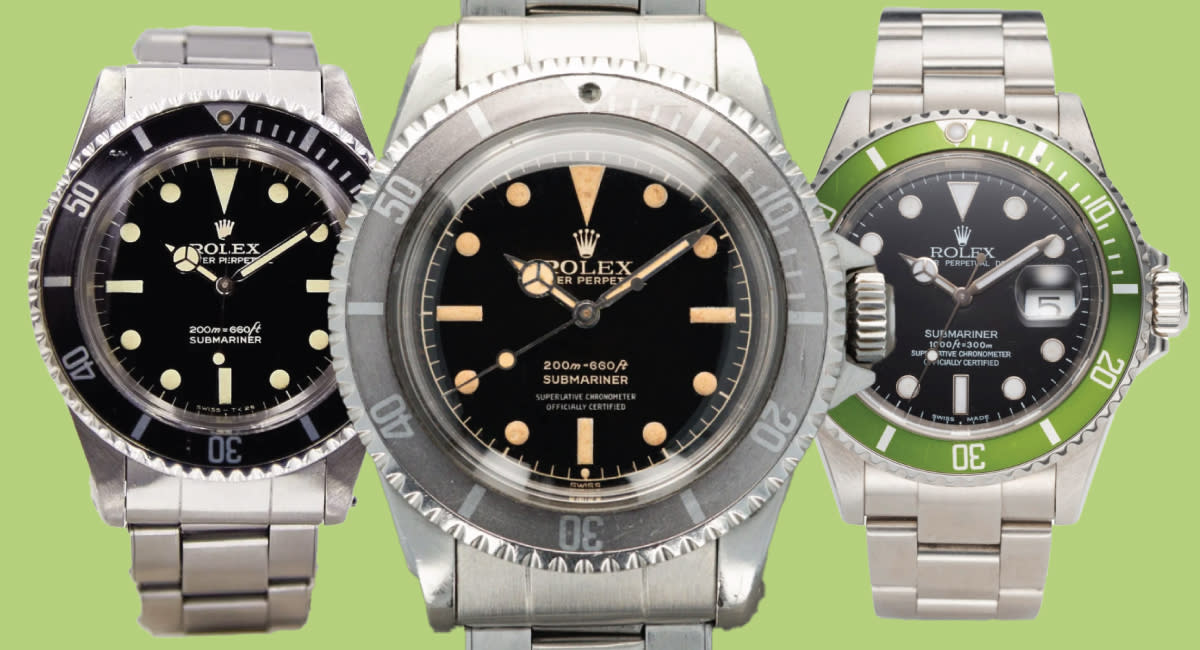
Rolex collectors may be the most pedantic crop of humans on Earth — but for good reason: Looking at minute details on your Rolex can reveal that it is rare and collectible…or not. But it’s good to know either way, for sure, and if you’re a first time Rolex buyer, or getting deeper into the weeds of collecting Rolex watches, you’ll want to know exactly what you’re looking at.
The largely endless supply of trivial-seeming minutiae can mean the difference between a $10,000 Rolex and a $100,000 Rolex. From tiny, barely visible lines and dots to serif and non-serif typography, from depth ratings in meters vs. feet to crown guards that look like avian beaks, the world of vintage Rolex is positively filled with quirky idiosyncrasies that can be difficult to parse, let alone memorize. And if you happen to find yourself at a watch swap or local collector’s meetup — oh boy. Be prepared for someone to talk your ear off about this stuff.
More from Robb Report
Thieves Are Stealing Rolexes and Pateks From Diners at N.Y.C.'s High-End Restaurants
Tudor Joined Forces With a Formula 1 Team to Create a New Black Bay Ceramic Watch
Best to study up then, wouldn’t you say? Our guide will give you a solid overview of some of the quirkier terminology that rears its head in Rolex collecting circles, whether vintage, neo-vintage, and even modern. And again, the difference between two otherwise-identical models with or without one of these features can mean big money.
NOTE: We’ve calculated premiums for a watch carrying a particular trait over a similar version that doesn’t carry said trait. In a fast-moving (and fickle) market, these are calculated to give you an average price differential, and shouldn’t be taken as gospel. Always do careful research and check with multiple, trusted watch dealers before making a purchasing decision. And it can be helpful to study market data, as well, which we’ve written about recently.
Best of Robb Report
Sign up for Robb Report's Newsletter. For the latest news, follow us on Facebook, Twitter, and Instagram.
Click here to read the full article.
Meters-First Dials
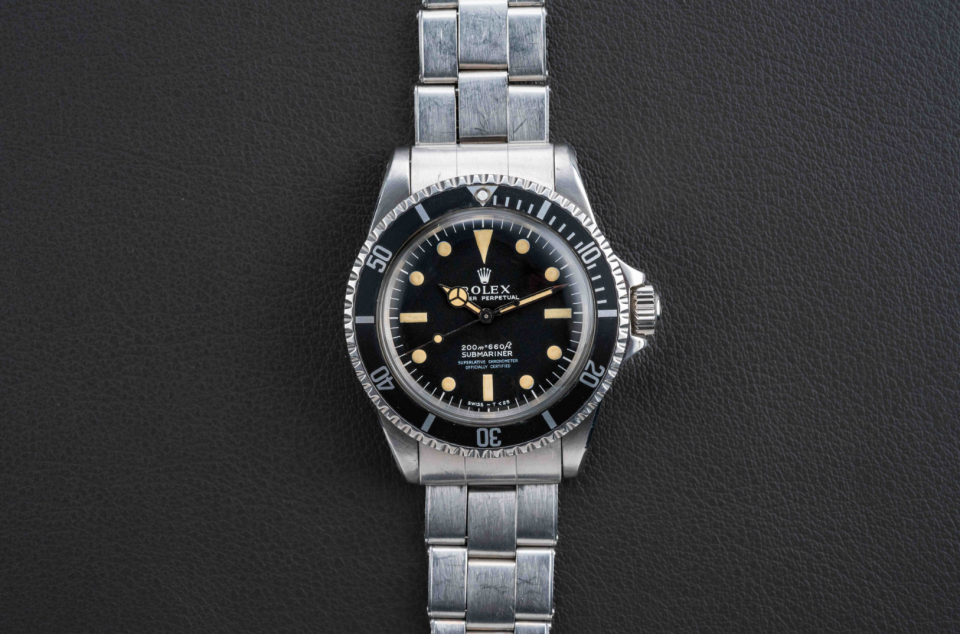
Perhaps in a bid to increase market share in the United States, Rolex changed its dial production to feature feet before meters in the depth rating around 1969. While reference 5512 Submariners in this configuration can feature two or four lines of text — the latter denoting chronometer certification — all feet-first 5512s have four lines. Reference 5513s — the non-chronometer-certified Sub sold alongside the 5512 — are a slightly different story: Early examples feature glossy-gilt dials in meters-first configuration; production switched to matte dials around 1969, but there are still meters-first examples in both glossy-gilt and matte. Finally, in the early 1970s, production switched to exclusively meters-first and stayed that way through the end of 5513 production in the late 1980s. Expect to pay perhaps a 66% premium for a meters-first, matte dial 5513 over a feet-first equivalent.
“Bart Simpson” Coronet
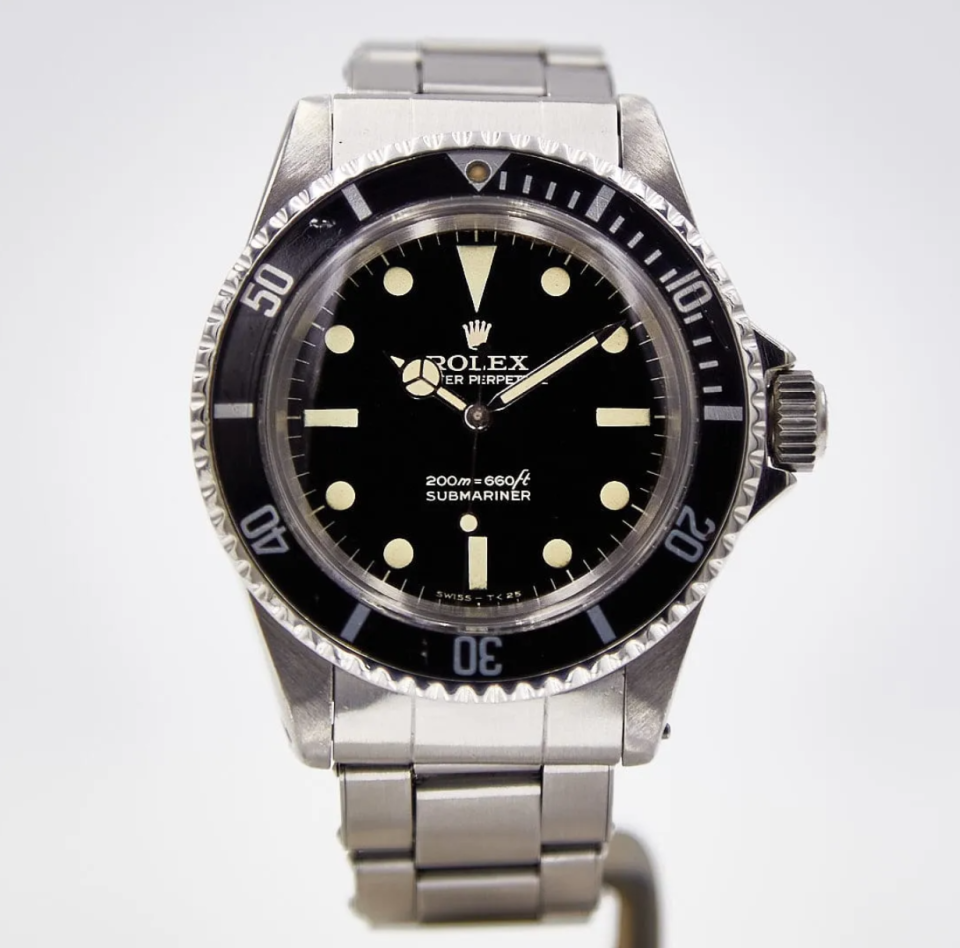
In the mid-1960s, during a time when Rolex was experimenting heavily with its coronet logo and wordmark, it produced a reference 5513 Submariner with a particularly quirky version. Made via a galvanic printing process that produced a yellowish hue, the coronet appears less defined than in other examples, and has since been named “Bart Simpson” by the collector community for its resemblance to the famed cartoon character’s head. A 5513 with such a coronet might carry roughly a 38% premium over a meters-first version with a more standard coronet.
Square Crown Guards
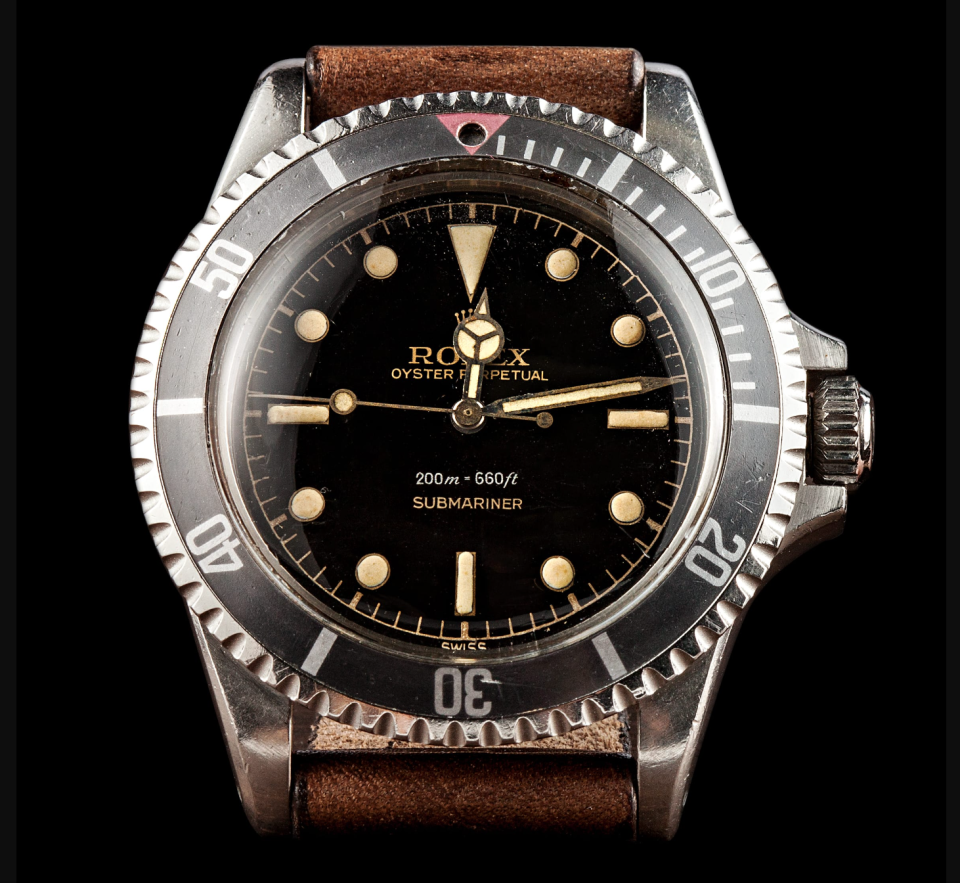
While early Submarines didn’t feature crown guards, the Crown added guards — see what I did there? — beginning with the introduction of the reference 5512 in 1959. However, these crown guards went through several iterations before Rolex arrived at the current, slightly rounded shape. The first crown guard type was what collectors refer to as “square,” which terminate in a noticeably flat top that’s parallel to the crown. Within the first year of 5512 production, the company would change to an “eagle beak” shape in order to offer better access to the winding crown, making watches with the “square” shape fairly rare, to the tune of perhaps just 100 pieces. If you can find one that also retains its original “red triangle” bezel, you’ll pay a premium of perhaps 100%.
Pointed Crown Guards (a.k.a PCG, or The Beak)
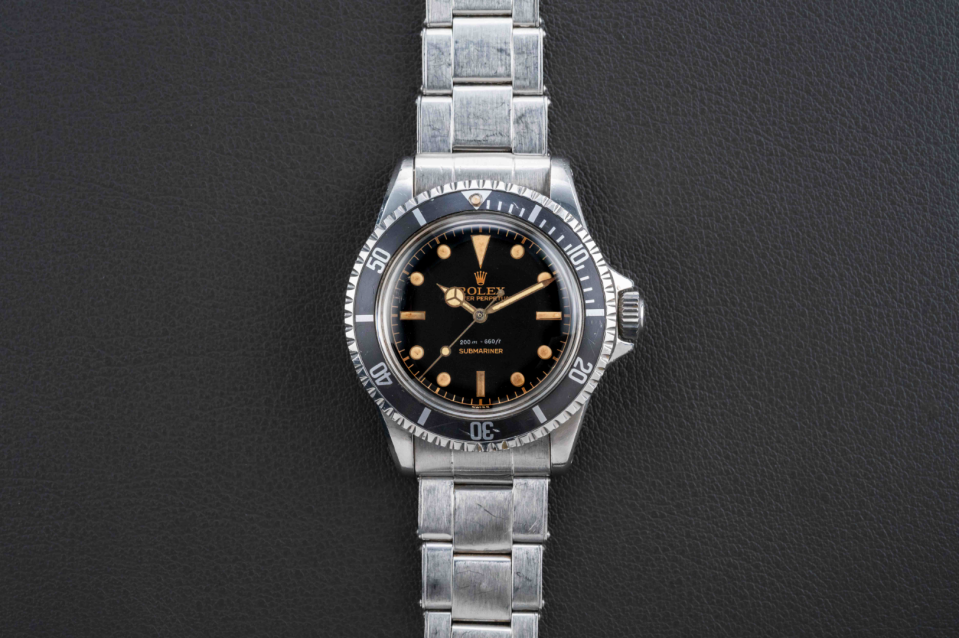
The reference 5512 Submariner was born in 1959 with square-ish crown guards, after which Rolex transitioned to what is referred to by collector’s as an “eagle beak” shape. After this, the Crown settled on a more pointed shape, known currently as “PCG” (“pointed crown guards), between roughly 1959-1963. (The final step in the process, in the mid-’60s, would be the transition to the rounded shape still seen on Rolex sport watch production today.) The move to PCG also coincided with the addition of two lines of “Chronometer Certification” text to the dial of the 5512, which would differentiate it from the non-chronometer certified, two-line ref. 5513 born around the same time. A “PCG” 5512 will be priced at roughly a 102% premium over a later, matte-dial 4-dial ref. 5512.
Flat-4 Bezel
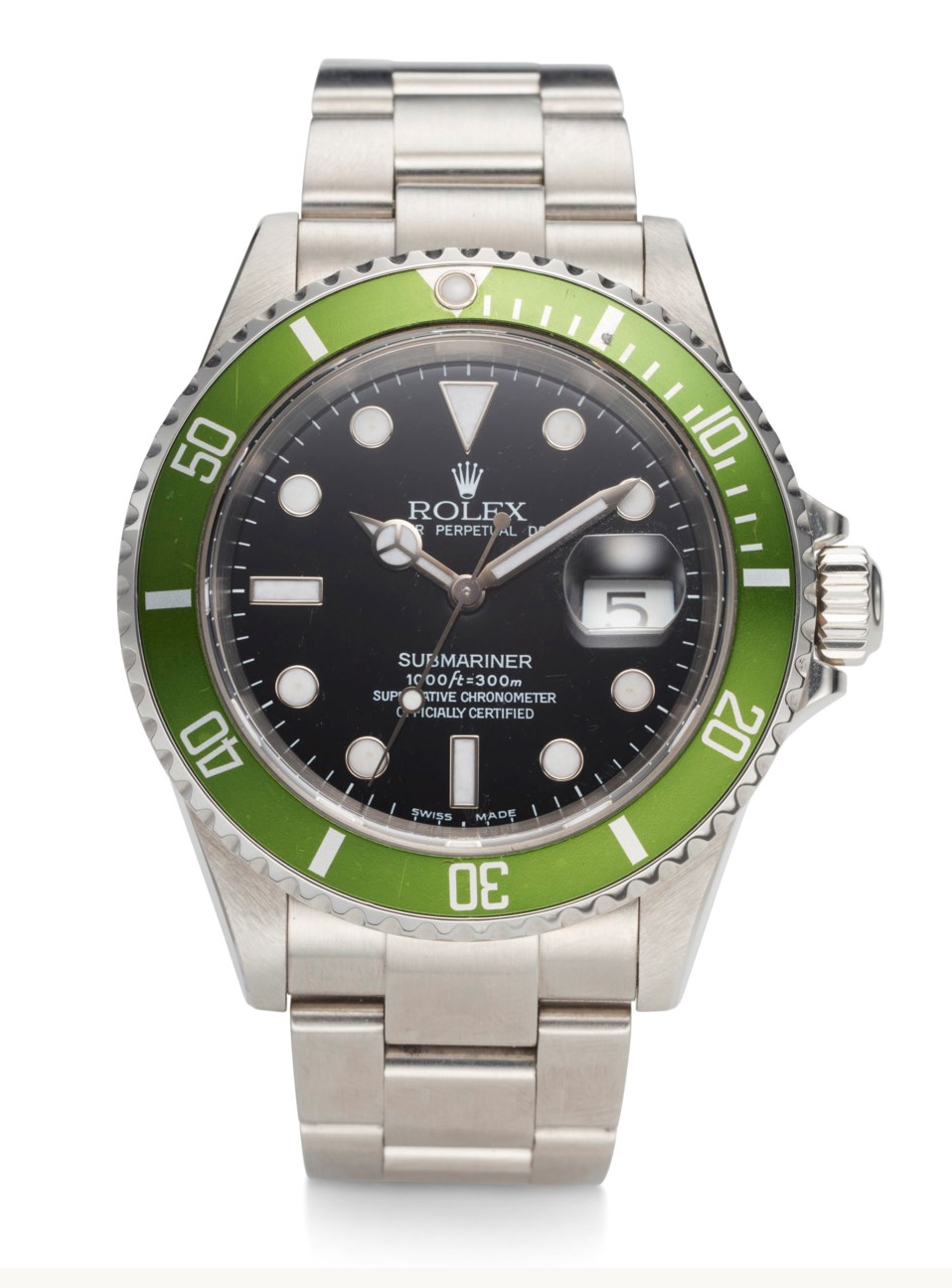
In 2003, Rolex debuted the Submariner reference 16610LV, the first stainless steel Submariner to feature a green bezel — or any color other than black, for that matter. The green bezel celebrated the Submariner’s 50th anniversary and was produced between 2003 and 2010. Certain early examples featured a “flat 4” bezel in which the flat top of the “4” numeral is flatter and the inside is more trapezoidal — later examples feature a sharper top and a triangular inner portion. These earlier “Flat 4” ref. 16610LV “Kermit” Submariners tend to carry a premium of perhaps 30-100%, depending upon condition and whether the watch carries its box, papers, etc.
Exclamation Dial
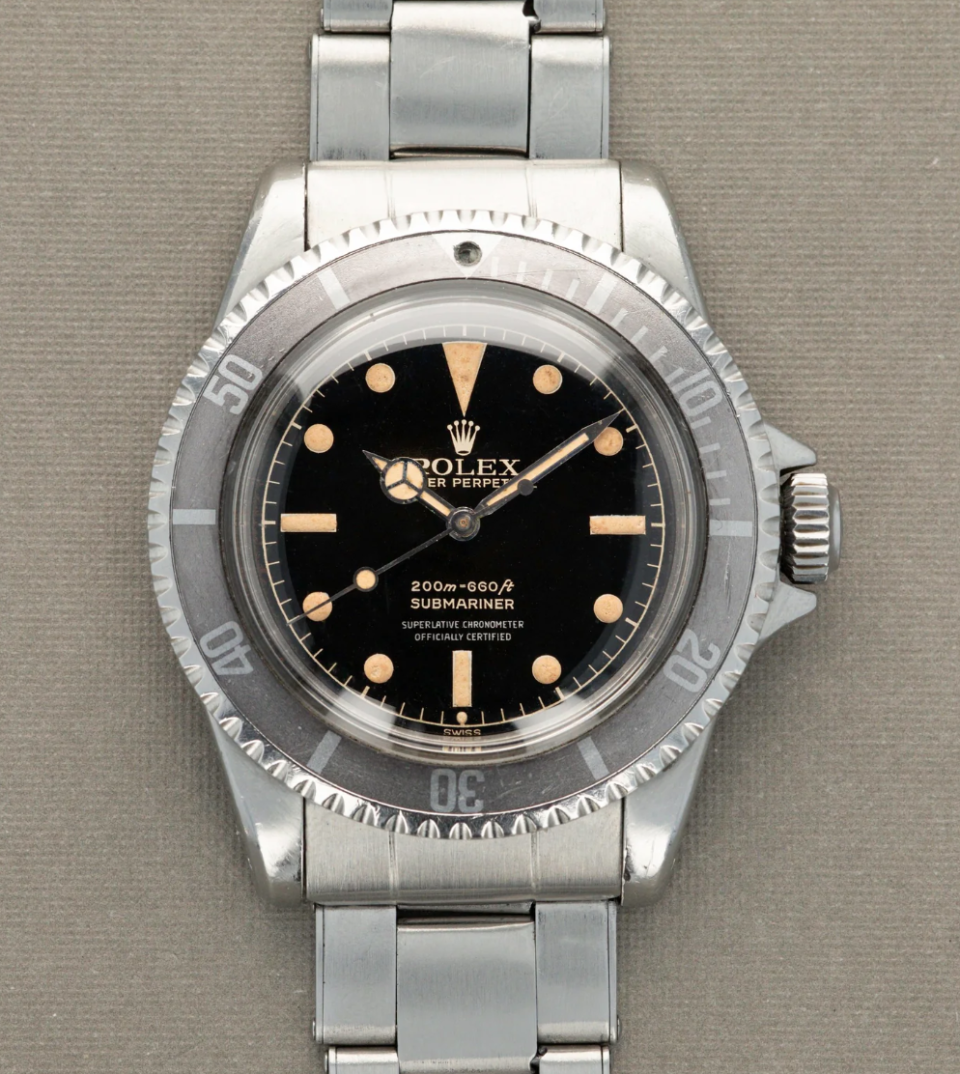
In the early 1960s, Rolex began adding a small luminous dot below the 12 o’clock baton maker on certain watch dials, the result of which looks like an exclamation point. It’s inferred that this strange symbol is indicative of a radium dial that conforms to Atomic Energy Commission guidelines from 1960, and that uses less radioactive material than earlier 1950s-era timepieces. The next step in this evolutionary process are the so-called “Underline” and “Swiss Underline” dials, which indicate that a watch dial — perhaps an old-stock dial — was either born with tritium, or has been upgraded with tritium. (Tritium is less radioactive, and thus less dangerous, than radium.) An exclamation-point 5512 dial — which is often seen with other highly desirable features — might add a 90% premium over a non-exclamation point, later 5512.
Underline/Double-Swiss-Underline
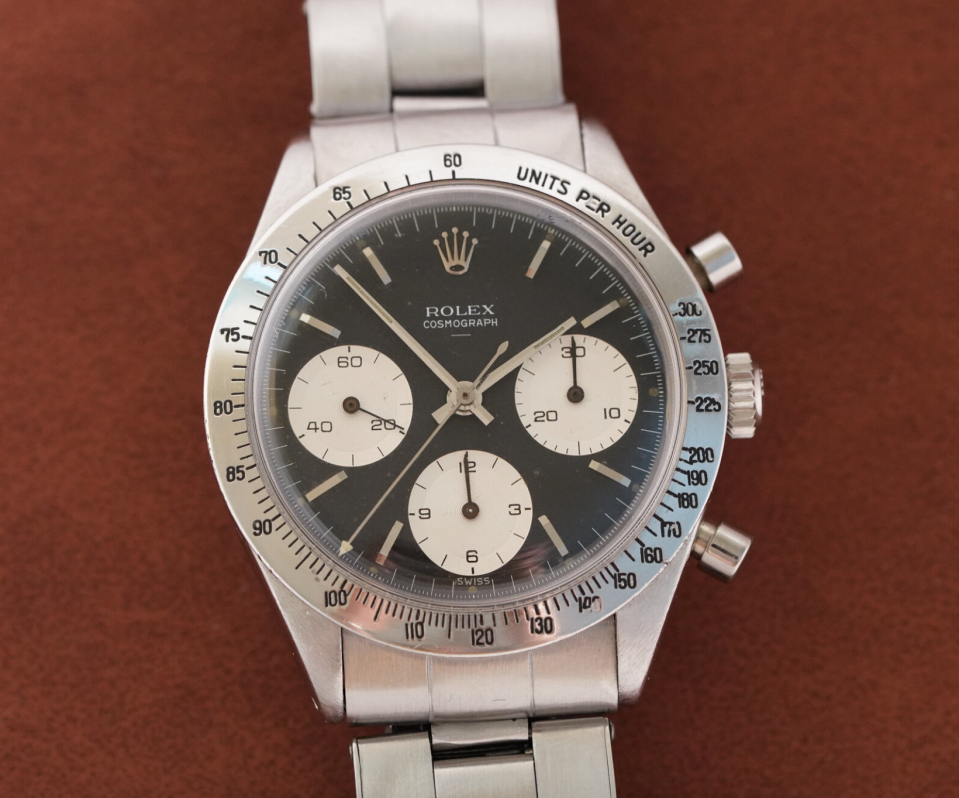
Also in the early 1960s — between 1962 and 1964, for the most part — Rolex began printing a thin horizontal line beneath the model name on the glossy-gilt dials of its sport watches. This is thought to denote a lower level of radiation found in their tritium luminescent material than that present in the radium of earlier luminescent dials, though Rolex has never confirmed this. (Underline dials are said to have lower Geiger counter readings in aggregate than exclamation dials.) There is also a special Submariner reference 5513 from roughly 1963 that features an underline beneath “Oyster Perpetual,” plus dual “Swiss” signatures above 6 o’clock. (There are also certain Cosmograph Daytonas with this feature.) An “Underline” 5513 is a rare bird, indeed, and might fetch a 92% premium over a more standard, meters-first 5513.
Red/Double-Red
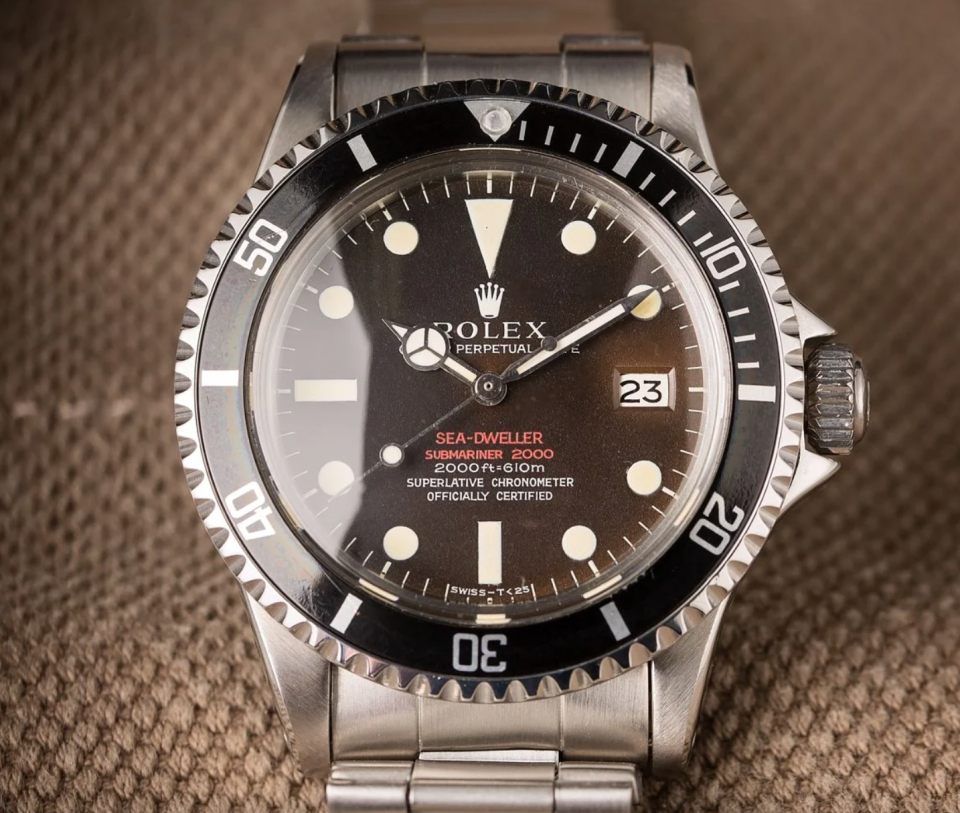
On the first iteration of the date-equipped Sub ref. 1680 from the late 1960s, Rolex placed four lines of text, the first of which (“Submariner”) is in red. This small quirk, which appeared in four successive iterations (“marks”) of 1680 and several further sub-sets, easily differentiates the “Red Sub” from other, similar watches. Later versions without red printing produced between 1976-1979 are less desirable (by rarefied vintage Rolex standards, anyway). Expect to pay a 61% premium for red text.
Confusingly, the Sea-Dweller — Rolex’s souped-up, ultra deep-diving version of the Sub — also went through a “red” phase: In its first iteration from 1967, it carried a single line of red text; later versions featured two lines of red text. (“Single-red” and “Double-red,” respectively.) Single-red models total about 12 in existence, and fetch multiple hundreds of thousands of dollars at auction. A DRSD will fetch roughly a 96% premium compared to a “Great White” Sea-Dweller with no red printing.
Gilt Dials
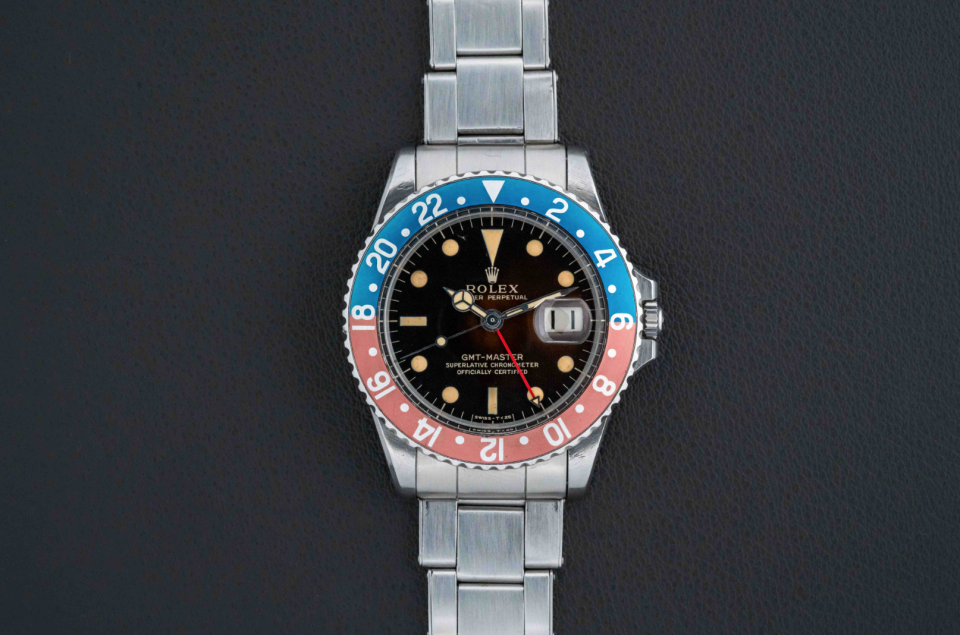
Though a “gilt” dial could mean several things, in vintage Rolex parlance, it applies to a dial type with gold-looking elements made prior to the late 1960s whose production involves a complex process: First, a brass dial blank is polished, after which certain elements — model name, depth rating, minute track, etc — are printed in a clear coating. Next, the dial is coated in black paint applied galvanically, which prevents the clear-printed elements from taking on the black color. Finally, the entire dial receives a clear lacquer coat. The resultant glossy dial is black and features certain elements that appear gold, giving it a refined, luxe look that collectors adore. (Rolex switched its production from “glossy-gilt” to matte dials around 1967.) Glossy-gilt sport watches are rarer than later matte versions by virtue of their production runs, and are thus more expensive. Expect to pay perhaps a 42% premium for a glossy-gilt” dial ref. 1675 over a matte-dial ref. 1675.
Explorer Dials
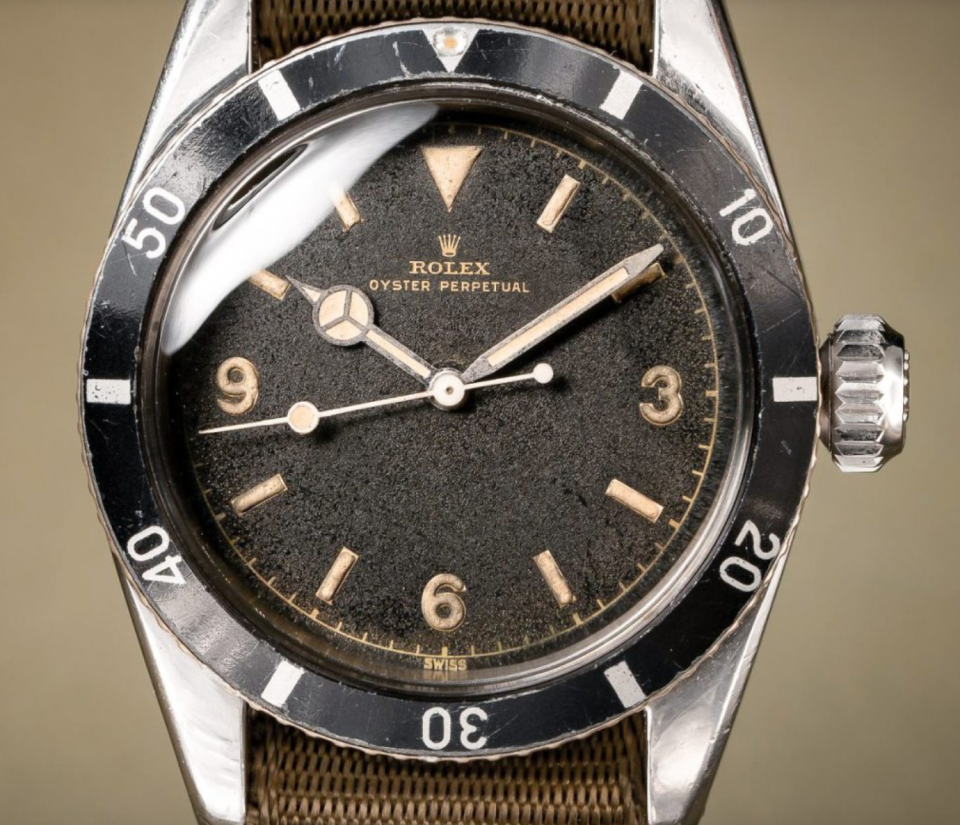
When someone refers to an “Explorer dial,” they’re referring to the dial type seen on an earlier Explorer I such as a ref. 1016 (or 6610.) But the Explorer I, with its combination Arabic, dash, and triangular indices with Mercedes hands, wasn’t the only Rolex model to use this dial: Indeed, there are certain Submariners that featured it as well, and they’re fairly rare. The super early ref. 6200 Submariner produced from 1955-1956 featured an Explorer dial — only perhaps 300 pieces are known worldwide. Likewise, the 6538, 5510, 5512, and 5513 also came in Explorer varieties, with the 5513 from between 1962-1965 constituting the last Explorer-dialed Sub. (Die-hard Rolex fans will note that the Commando, an über-scarce 34mm Oyster cased watch sold at Abercrombie & Fitch and U.S. military PXs, also has an Explorer dial.) Expect to pay six figures for an Explorer-dial 5513, or roughly a 148% premium over a standard matte-dial 5513.
Maxi Dials
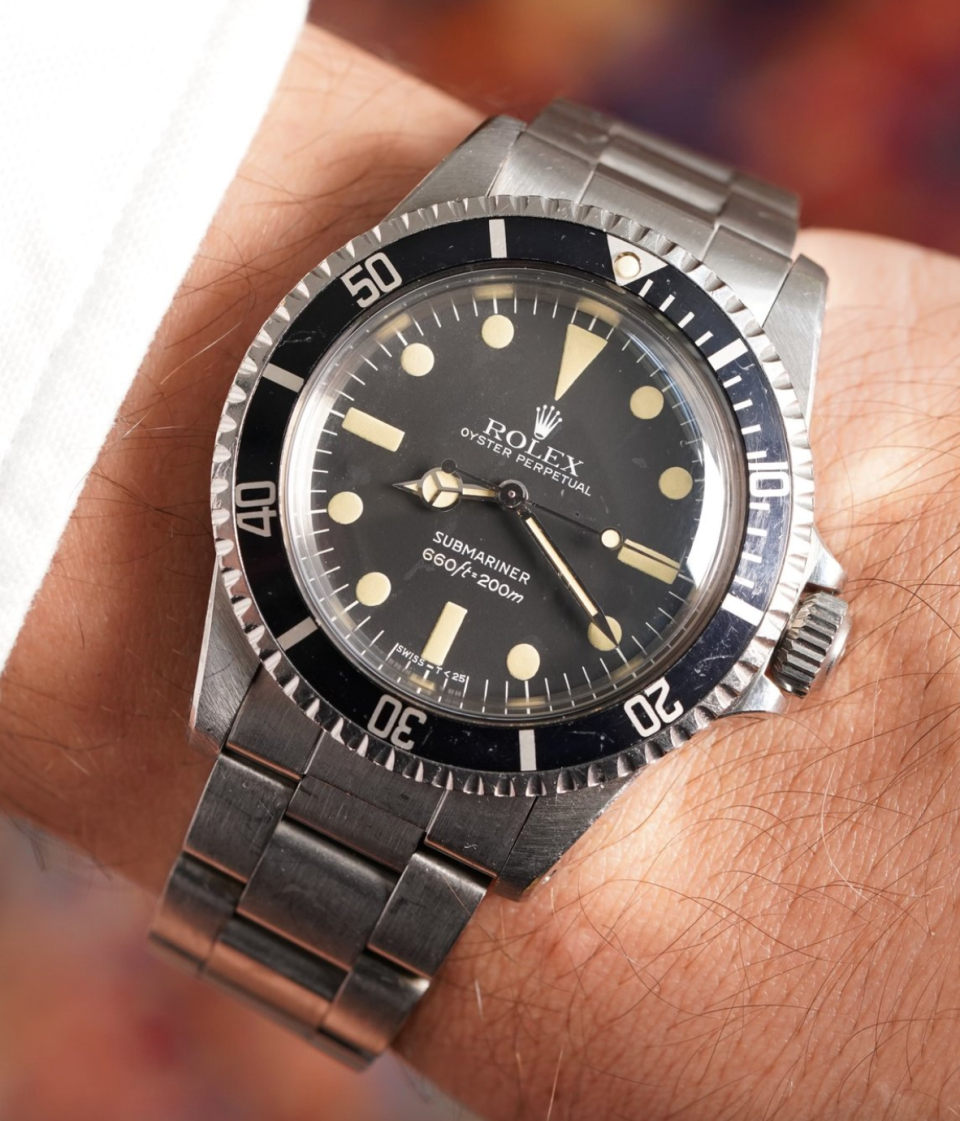
Debuting in the mid-1970s, the “Maxi” dial — a collector term — is one on which the luminous tritium hour plots are enlarged, presumably for better visibility. (Holding a “Maxi” dial Sub next to an earlier-production model makes the difference obvious.) Small variants in production mean that there were multiple “Maxi” dials produced until the mid-1980s, when production switched back over to regular-sized lume plots. (Rolex would re-introduce it on the ref. 16610LV Submariner in 2003.) A “Maxi”-dial ref. 5513 with pleasing patina might carry an 11% premium over a slightly later 5513 with white gold surrounds from the late 1980s.


